Menu
-
MenuBack
- Home
-
Categories
-
-
Categories
-
Vegetable Seeds
-
Varieties by Country
- Varieties from Armenia
- Varieties from BiH
- Varieties from Croatia
- Varieties from France
- Varieties from Germany
- Varieties from Greece
- Varieties from Hungary
- Varieties from India
- Varieties from Italy
- Varieties from Japan
- Varieties from North Macedonia
- Varieties from Peru
- Varieties from Russia
- Varieties from Serbia
- Varieties from Slovenia
- Varieties from Spain
- Varieties from Thailand
- Varieties from Turkey
- Varieties from USA
- Tomato Seeds
- Corn Seeds
- Gourd family
- Bean family
- Cucumber Seeds
- Pepper Seeds
- Carrot family
- Onion family
- Lettuce Seeds
- Potato family
- Cabbage family
- Radish Seeds
- Beetroot family
- Watermelon Seeds
- Melon Seeds
- Cauliflower Seeds
- Sunflower family
-
Varieties by Country
- Fruit Seeds
- Chili - Habanero Seeds
- Medicinal Herb Seeds
- Climbing Plants Seeds
- Trees Bonsai Seeds
- Palm Seeds
- Ornamental Grasses Seeds
- Tobacco Seeds
-
Vegetable Seeds
-
-
-
-
- NEW PRODUCTS
- Create account
- Delivery - Payment
- FAQ
Last Product Reviews
Out of the two seeds, one germinated and the other one was dead and floatin...
By
 Riikka H on 07/03/2024
Riikka H on 07/03/2024
Verified Purchase
There are 22 products.
Showing 16-22 of 22 item(s)

Giant plant (with giant fruits)

Giant Yellow Eckendorf Beet...
Price
€1.85
(SKU: VE 63 E (3g))
Seeds Gallery EU,
5/
5
<h2><strong>Giant Yellow Eckendorf Beet Seeds</strong></h2>
<h2><span style="color: #ff0000;"><b style="color: #ff0000;">Price for Package of </b><font color="#ff0000" class=""><b>100 (3g)</b></font><b style="color: #ff0000;"> seeds.</b></span></h2>
<p>The 1927 Henry Fields catalog said, “Giant, smooth, long roots of cylindrical shape, weighing up to 9 kg (20 pounds) each and growing two-thirds above ground. Solid white flesh with high food value.” These big yellow-skinned roots are perfect for growing as animal food, a tradition that is finally being brought back on many small farms.</p>
<p>High nutrition and vitamin content, tops are rich sources of vitamin C, eat-in salads or soups. A native of northern Africa and the western Mediterranean, ancient Greeks have used leaves only. Beetroot can be steamed with other vegies or grated raw as well as boiled and pickled for salads. Best results in soil with PH over 6 and if always kept moist. Can sow indoors and transplant. Thin to 30-50mm, young thinnings may be transplanted older thinnings as a leaf vegetable, sow after frost. Roots store well after harvest. Sow spring to autumn, anytime in mild climates. 50-90 seeds per gram</p>
<p><strong>Uses</strong></p>
<p>Contemporary use is primarily for cattle, pig and other stock feed, although it can be eaten – especially when young – by humans. Considered a crop for cool-temperate climates, the mangelwurzel sown in autumn can be grown as a winter crop in warm-temperate to sub-tropical climates. Both leaves and roots may be eaten. Leaves can be lightly steamed for salads or lightly boiled as a vegetable if treated like English spinach. Grown in well-dug, well-composted soil and watered regularly, the roots become tender, juicy and flavourful. The roots are prepared boiled like potato for serving mashed, diced or in sweet curries. Animals are known to thrive upon this plant; both its leaves and roots provide a nutritious food. George Henderson, a 20th-century English farmer and author on agriculture, stated that mangel beets were one of the best fodders for dairying, as milk production is maximized.</p>
<p>The mangelwurzel has a history in England of being used for sport,[5] for celebration, for animal fodder and for the brewing of a potent alcoholic beverage. The 1830 Scottish cookbook The Practice of Cookery includes a recipe for a beer made with mangelwurzel.[6] In 19th-century American usage, mangel beets were sometimes referred to as 'mango.'</p>
<p>During the Irish Famine (1845–1852), Poor Law Guardians in Galway City leased (on a 999-year-lease) a twenty-acre former nunnery to house one thousand orphaned or deserted boys ages from five to approximately fifteen. Here the boys were taught tailoring, shoe making, and agricultural skills. On a five-acre plot, they grew potatoes, cabbage, parsnips, carrots, onions, Swedish turnips, and "mangold wurtzel"--both for workhouse consumption as well as for a cash crop. See Lord Sydney Godolphin Osbourne's "Gleanings in the West of Ireland" published in London 1850, T & W Boone, page 58.</p>
<p>As with most foods, subsisting on solely one crop can produce dietary deficiency. The food shortages in Europe after World War I caused great hardships, including cases of mangel-wurzel disease, as relief workers called it. It was a consequence of eating only beets.</p>
<p><strong>Growing requirements</strong></p>
<p>In general, mangelwurzel are easy to grow. They may require supplementary potassium for optimum yields, flavour and texture, and foliage readily displays potassium deficiency as interveinal chlorosis. This can be corrected with either organic or nonorganic sources of potash.</p>
<p><strong>In tradition</strong></p>
<p>In South Somerset, on the last Thursday of October every year, Punkie Night is celebrated. Children carry around lanterns called "Punkies", which are hollowed-out mangelwurzels. Mangelwurzels are also carved out for Halloween in Norfolk and Wales. Also N.W. Cumberland (Workington), in the 1940s and 50s -- for "Jack o'Lantern" night.</p>
<p>John Le Marchant recommends cutting the "mangel-wurzel" to learn the proper mechanics for a draw cut with the broadsword in his historic manual on swordsmanship.</p>
<p><strong>In popular culture</strong></p>
<p>It is the source of the name for the English folk/pop/comedy/scrumpy-and-western musical group The Wurzels.</p>
<p>English comedian Tony Hancock made a short song about mangelwurzels in the Hancock's Half Hour episode "The Bowmans".</p>
<p>The mangelwurzel is featured in the 1984 novel Jitterbug Perfume written by Tom Robbins. The main character Alobar originally hails from a Slavic nation where beets are quite prevalent, and eventually the mangelwurzel is used as the base note in the mysterious perfume from which the book derives its name.</p>
<p>The mangelwurzel also had a role in the cult TV kids show as Worzel Gummidge's head, where it could often be heard to say things like "go boil your head."</p>
<p>Mangels are a frequently mentioned animal fodder in George Orwell's novel, Animal Farm.</p>
<p>Mangel wurzel is the only vegetable that was available for Sarah Bruckman to purchase in Two Fronts by Harry Turtledove. Turtledove also uses it as a staple of the post-eruption Maine diet in his Supervolcano series.</p>
VE 63 E (3g)

- On sale!

Variety from Hungary
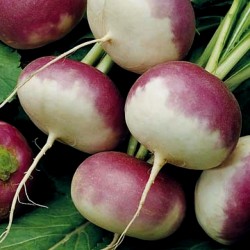
Hungarian Sugar beet seeds...
Price
€2.25
(SKU: VE 163 (1g))
Seeds Gallery EU,
5/
5
<h2><strong>Hungarian Sugar beet seeds Horpácsi</strong></h2>
<h2><span style="color: #ff0000;" class=""><strong>Price for Package of 500 (1g) seeds.</strong></span></h2>
<p>Due to the sufficiently sweet radish taste in the rainy landscapes of Hungary, it is grown not only for fodder but also for food. It is pickled like sauerkraut. It is frost tolerant and can be harvested in late autumn. Its root is flat, round, the apical part is purple in color, protruding slightly from the ground. Sugar beet seeds Horpácsi is not sensitive to frost, it still grows during the autumn, you can pick it up in late autumn.</p>
<p>Sowing depth: 2-3 cm.<br>Optimal germination temperature: 10-15 ° C.</p><script src="//cdn.public.n1ed.com/G3OMDFLT/widgets.js"></script>
VE 163 (1g)


Plant resistant to cold and frost

Variety from Hungary

Coming Soon
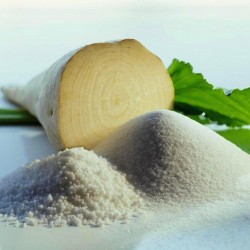
Sugar beet seeds Authority...
Price
€1.75
(SKU: P 8)
Seeds Gallery EU,
5/
5
<meta http-equiv="Content-Type" content="text/html; charset=UTF-8" />
<h2><strong>Sugar beet seeds Authority - Heirloom</strong></h2>
<h2><span style="color: #ff0000;"><strong>Price for Package of 20 seeds.</strong></span></h2>
<p>Sugar beet - a cold-resistant, light-loving culture, medium-demanding to the fertility of the soil. Sugar beet gives high stable yields, easy to transport. Sugar beet loves heat, light, and moisture.</p>
<p>The amount of sugar in the fruit depends on the number of sunny days in August — October. Sugar beet is used not only for making sugar but also for feeding animals.</p>
<p>The optimum temperature for seed germination is 10–12 ° C, growth, and development is 20–22 ° C. Shoots are sensitive to frost.</p>
<p>Name: Sugar beet Authority<br />Harvest: 75-100 days<br />Root weight: 500-850 g<br />The sugar content: 18-21%<br />Sowing depth: 2-3 cm.</p>
<p>tion temperature: 10-15 ° C.</p>
P 8 (20 S)


Variety from Slovenia
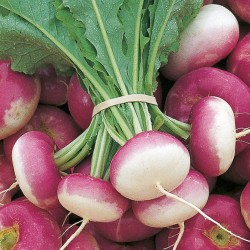
Beet Kranjska round seeds
Price
€1.45
(SKU: VE 105)
Seeds Gallery EU,
5/
5
<!DOCTYPE html>
<html>
<head>
<meta http-equiv="Content-Type" content="text/html; charset=UTF-8" />
</head>
<body>
<h2><strong>Beet Kranjska round seeds</strong></h2>
<h2><span style="color: #ff0000;"><strong>Price for Package of 300-400 (1g) seeds.</strong></span></h2>
<p>Kranjska Beet is an early variety for use without delay, and it is good for pickling and fresh consumption. It has a flat round shape with a red-purple head. If there is enough moisture, it thrives in any soil. It grows well in the vicinity of lettuce, spinach and beans.</p>
<p>A thickened round or cylindrical root is used as a food. At its apex is a rosette with oval elongated leaves that are light green in color and hairy. There are clustered inflorescences on the stem. In 1 g can be 300 - 400 seeds.</p>
<p>Beetroot is grown after cereals, industrial peas or early fodder crops. It is used in combination for human consumption, and part as fodder. It thrives in any sufficiently moist soil.</p>
<p>It does not tolerate stagnation (water retention). It is most profitable to grow it with irrigation.</p>
<p>Beetroot must not be sown in the same place for at least 3-4 years, and at that time there must be no other cabbages in that place.</p>
<p>Sowing / planting of turnips</p>
<p>Germ beet seeds germinate for about 15 days. The minimum germination temperature is 5 ºC and the optimum 20 ºC. It can withstand mild frosts down to -4 ºC if they do not last longer.</p>
<p>It is mostly grown by direct sowing, but it is also possible to grow from seedlings. It is sown with a precision seed drill. In European countries, early cultivars are grown by sowing from March to May with a row spacing of 20-30 cm, and a row spacing of about 10 cm, which requires 1.5-2.5 kg / ha of seeds. In 80-60 days the thickened root reaches a diameter of 6-10 cm, when it is ready for harvest.</p>
<p>If it is planned to sow 15 - 20 plants / m2, it is sown at a row spacing of 40 cm and a row spacing of 5 - 10 cm. Depending on the pre-culture, it can be sown from late June to mid-July.</p>
<p>Harvesting and storage of turnips<br />Lateral beets are harvested in the second half of October or early November before severe frosts. It is taken out with suitable excavators, the leaves are cut off and sorted by size. Yields mostly depend on the achieved composition and the amount and distribution of precipitation, and can be 20 - 60 t / ha.</p>
</body>
</html>
VE 105 (100 S)

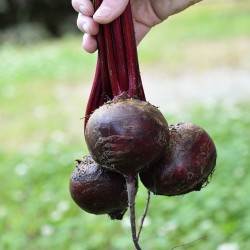
Detroit Beetroot Seeds
Price
€1.35
(SKU: VE 204 (2g))
Seeds Gallery EU,
5/
5
<div>
<h2><strong>Detroit Beetroot Seeds</strong></h2>
<h2><span style="color: #f80000;"><strong>Price for Package of 120 (2g) seeds.</strong></span></h2>
<div>
<p></p>
<p class="">Beetroot - Detroit is a very old variety of beet that still behaves extremely well. A very popular variety for cultivation. The dark red globe-shaped roots grow up to 7 cm, and it tastes very good. Green tops with shades of dark red.<br><br>This medicinal plant has been known as a medicine for some 2000 years. Beetroot is a natural antianemic, antibacterial, anticancer, antipyretic, antioxidant, antisclerotic, detoxifying, diuretic, remineralizing.<br><br>Beetroot juice regenerates the liver and prevents aging. Even in early medicine, beets are a remedy for blood, more precisely the treatment of anemia, although it has a curative effect on a number of other diseases.<br><br>Beets successfully regulate blood pressure. Beetroot juice is a useful antipyretic, because it lowers high body temperature. Beetroot seeds are used for the therapeutic treatment of genital and intestinal tumors.</p>
</div>
<p><strong>How to grow Beetroot:</strong></p>
</div>
<div>Beetroot is remarkably easy to grow and can be grown across a wide range of climates. It prefers moist, sunny conditions with not excessive heat. It is sown as a warm-season crop in most regions but performs best during the cooler, drier months in tropical zones where it may prefer some shade in summer conditions</div>
<div>Beetroot can be sown from very early in the season until late and can be grown in raised beds or containers all year round. Sow the seeds closer together for cutting and use in baby leaf salads, they can be constantly thinned, as you need them throughout the growing period. The young shoots are also deliciously sweet. </div>
<div>Beetroot seeds are clustered together with each cork-like fruit containing two or three seeds. Once germinated, they require thinning out early to avoid root disturbance. (Some varieties have been bred to only produce one seed and are called 'Monogerm' seeds).</div>
<div>
<p></p>
<p><strong>Position:</strong></p>
</div>
<div>Beetroot prefer to be grown in light, sandy soil in a sunny position, but can tolerate pretty much any sort of soil and some shade will be tolerated, a pH of 6.0-7.0 is fine but if you know your soil is too acid dig in some lime. </div>
<div>Dig over the site with a spade (preferably in the autumn prior to sowing). Remove perennial weeds and large stones as these can cause the roots to become mis-shapen</div>
<div>Level roughly and then work over the area with a rake to leave a fine finish. If you can, two or three weeks before sowing, spread a general granular fertiliser across the site and rake into the soil. Do not add manure to the soil as this will cause the roots to develop incorrectly.</div>
<div>
<p></p>
<p><strong>When to sow Beetroot: </strong><br>Late spring to autumn.</p>
</div>
<div>Beetroots can be grown from early spring onwards if grown indoors or undercover. </div>
<div>Seeds can be planted directly into the ground after the threat of frost has passed. Beetroots are best planted at soil temperatures between 7°C and 25°C. The best quality beetroots are grown at temperatures of 10 to 18°C (50 to 65°F).The crops will tolerate light frost.</div>
<div>
<p></p>
<p><strong>How to sow Beetroot:</strong></p>
</div>
<div>The seeds require plenty of moisture to germinate. Soaking them in warm water for an hour or two prior to planting is a great way to speed up germination. Expected germination time 10 to 14 days. </div>
<div>Prevent a glut when planting beetroot by sowing your seed in stages, a small batch at a time every couple of weeks will give a continuous harvest.</div>
<div>
<p></p>
<p><strong>Sowing Indoors: </strong><br>From February</p>
</div>
<div>Sow 2 or 3 seeds per pot, at a depth of 25mm (1in). When the seedlings emerge there may be more than one from each seed cluster. When they are about 5cm (2in) tall, carefully separate these into individual plants prior to planting out (only transplant the strongest seedlings). This will avoid seedlings competing with one another and prevent a distorted, misshapen harvest. </div>
<div>Successful transplanting can be carried out as soon as plants have formed their first true leaves. Unlike other root crops, beetroot seedlings transplant reasonably well providing they are not too large and are kept moist when transplanting.</div>
<div>
<p></p>
<p><strong>Sowing Direct: </strong><br>From May</p>
</div>
<div>It is best to sow beetroot seeds directly into the ground when the temperature of the soil has warmed to about 7°C (44°F). Sow thinly in prepared seed beds. Where plants are sown direct it is important to thin the multiple seedlings back to one plant. If carefully removed, the thinnings can be transplanted to form additional rows.</div>
<div>The spacing is quite important. If you wish to grow small, pickling size beets, they need to be sown quite close together, about 5cm (2in) apart, in rows 15cm (6in) apart. If you wish to grow standard size beetroots, then sow about 10cm (4in) apart, in rows that are at least 30cm (12in) apart.</div>
<div>Cover lightly with 25mm (1in) of fine soil. Firm gently, water well and keep moist. </div>
<div>Seedlings appear in 7 to 21 days. When large enough thin to at least 10cm (4in) apart.</div>
<div>
<p></p>
<p><strong>Cultivation: </strong></p>
</div>
<div>Keep the rows weed free and the seedlings well watered. Once the roots have developed and they start to swell, beetroots need to be watered moderately. Beetroot has shallow roots and it is important to keep the plants moist. If they experience long dry periods, the beetroot will become hairy and fibrous. Intermittent or inadequate watering can result in stress cracks and breakdown of roots. Don't overwater as this only encourages leaf growth and not bulb growth. </div>
<div>
<p>During cool weather, the plants can be watered once a week. During very hot weather, less water can be given two to three times a week instead of a lot of water once a week.</p>
</div>
<div>
<p><strong>Companion Planting: </strong></p>
<p>Good Companions - Onions, Silverbeet, Kohlrabi, Lettuce, Cabbage, Dwarf Beans. Aromatic Herbs, Celery, Chamomile, Spinach, Chard.</p>
</div>
<div>Bad Companions - tall beans, runner beans.</div>
<div>
<p></p>
<p><strong>Common Problems: </strong></p>
</div>
<div>Boron deficiency is sometimes seen in root vegetable crops. This causes leaf yellowing and scorching. It is very rare if general purpose fertiliser is used that includes trace elements such as boron, magnesium, manganese, iron and molybdenum.</div>
<div>Fungal leaf spots and rust sometimes occur on beetroot leaves. These are worse when plants are poorly grown (lack of sun, water and nutrients) or planted at the wrong time of year. Avoid growing beetroot during most humid time of the year in tropical regions, improve air circulation, reduce nitrogen applications and avoid excessive wetting of the foliage. Apply seaweed sprays to build disease resistance and supply trace elements.</div>
<div>Slugs or snails may eat the leaves. Repellent molasses or chilli spray, or barriers and traps to control slugs and snails may be required in extreme cases.</div>
<div>
<p></p>
<p><strong>Propagation:</strong></p>
</div>
<div>Beetroot are both wind and insect pollinated; they will cross with silverbeet, chard and other beets. </div>
<div>Plants are biennial, producing vegetative growth in the first season and flowers and seed in the second. If plants bolt, eat do not allow to go to seed.</div>
<div>Do not have two varieties in flower at the same time or isolate plants to keep different strains pure. Where possible, allow at least three to four plants of one variety that show good growth and disease resistance for flowering and seed production.</div>
<div>
<p></p>
<p><strong>Harvesting: </strong></p>
</div>
<div>Beetroot is ready to be picked when the roots are between the size of a golf ball and a tennis ball – this is usually 12 to 16 weeks after sowing. The smaller the root the better the quality. </div>
<div>Pull from all along the row and not just in one place, as this thins out the rows, allowing more space for the other beetroot to grow. To harvest, gently hold the tops and lift while levering under the root with a hand fork. Remove the tops by twisting them off with your hands to prevent the plants bleeding their juice – don’t throw these away, they have bags of taste and can be cooked and eaten like spinach. Store roots in dry sand, soil, or peat for winter use.</div>
<div>
<p></p>
<p><strong>Culinary Uses:</strong></p>
</div>
<div>Before cooking beets, cut off the tops within a couple of inches of the top. This helps lock in the nutrients during cooking. When the tops are attached to any root vegetable, they leech the nutrients from the root. They should be cooked whole and then peeled; otherwise, they bleed all their colour and nutrients into the water. </div>
<div>The deep-red roots are eaten Boiled, steamed or roasted as a vegetable (if roasted, cover with lemon juice to stop browning). They can be eaten cold as a salad after cooking and adding oil and vinegar, or raw and shredded. </div>
<div>A large proportion of commercial production is processed into boiled and sterilised beets or into pickles. In Eastern Europe beet soup, such as cold borscht, is a popular dish. Beetroot leaves are lovely in a salad or cooked. Use as you would spinach.</div>
<div>Beetroot can easily be stored for later use, and the most common method is by pickling them in vinegar.</div>
<div>
<p></p>
<p><strong>Storing:</strong></p>
</div>
<div>The greens and the roots should be stored separately as the greens are highly perishable, but the roots can last for some time in storage. Another method to store beetroot is pickling and making chutney.</div>
<div>
<p></p>
<p><strong>Other Uses:</strong></p>
</div>
<div>Beetroot is known for staining the tablecloth, but can be used to make an excellent natural dye. It gives a fantastic range of colours, from yellow, through reds to browns, dependent on the type of mordant used. Within older bulbs of beetroot, the colour is a deeper crimson and the flesh is much softer. Beetroot dye may also be used in ink.</div>
<div>Betanin, obtained from the roots, is used industrially as red food colourants, e.g. to improve the colour of tomato paste, sauces, desserts, jams and jellies, ice cream, sweets and breakfast cereals.</div>
<div>
<p></p>
<p><strong>Origin:</strong></p>
</div>
<div>Beetroot are biennial plants grown as annuals and harvested for their swollen root tuber and leaves. The type of wild plant from which it came, had thin, poor roots and was native to the Mediterranean but spread eastwards into West Asia. It was known as a vegetable as early as 300 BC but was only introduced into Germany and Britain around the sixteenth century.</div>
<div>Beetroots are related to the sugar beet and to swiss chard, the foliage beets that are grown for the greens and not the root.</div>
<div>
<p></p>
<p class=""><strong>History: </strong></p>
</div>
<div>From the Middle Ages, beetroot was used as a treatment for a variety of conditions, especially illnesses relating to digestion and the blood. Platina recommended taking beetroot with garlic to nullify the effects of 'garlic-breath'.</div>
<div>Since Roman times, beetroot juice has been considered an aphrodisiac and natural Viagra. </div>
<div>It is a rich source of the element boron, which plays an important role in the production of human sex hormones. Field Marshal Montgomery is reputed to have exhorted his troops to 'take favours in the beetroot fields', a euphemism for visiting prostitutes.</div>
<script src="//cdn.public.n1ed.com/G3OMDFLT/widgets.js"></script>
VE 204 (2g)


Variety from Spain

Plant resistant to cold and frost
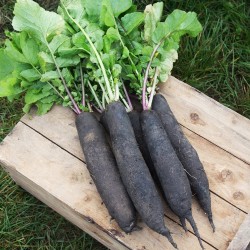
Black mountain beet seeds
Price
€1.25
(SKU: P 4)
Seeds Gallery EU,
5/
5
<h2 class=""><strong>Black mountain beet seeds</strong></h2>
<h2><span style="color: #ff0000;"><strong>Price for Package of 20 seeds.</strong></span></h2>
<p>Variety with dark brown or black skin and white meat, long and thin, about 20cm. very adapted to cold and dry climates.<br /><br />The black mountain turnip is a root, a tuber with black skin and whitish flesh with a pleasant and slightly spicy flavor. It is harvested in winter and consumed until March. It is finer and tastier than the rest of the turnip varieties.<br /><br />It is used for creams or soups, but also for garnish and raw in salads, or fried like potatoes.<br /><br />Origin: Les Refardes - Spain</p>
<script src="//cdn.public.n1ed.com/G3OMDFLT/widgets.js"></script>
P 4 (20 S)










